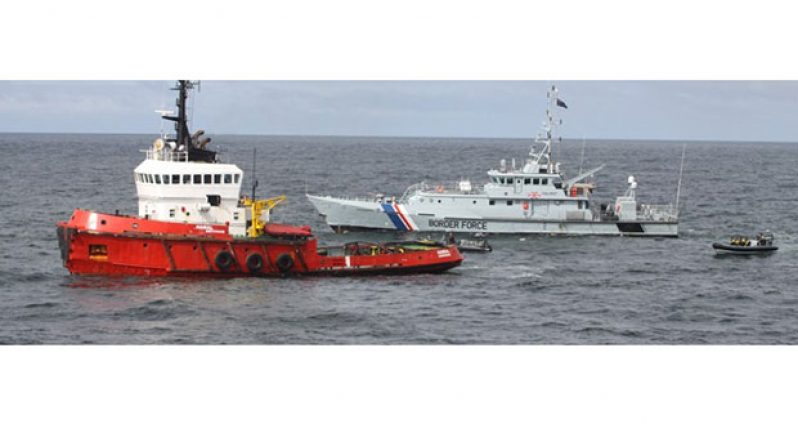By Svetlana Marshall
THE Customs Anti-Narcotics Unit (CANU) and the Guyana Police Force (GPF) have been cited for support given to the United Kingdom’s National Crime Agency (NCA), which has resulted in the conviction of two Turks who were caught trafficking in excess of 3.2 tonnes of cocaine.Once adulterated, this haul of cocaine had an estimated potential street value of £512M.

The substance was found hidden on board the Tanzanian-flagged MV Hamal in April 2015; and following a 12-week trial at the High Court in Glasgow, Scotland, the ship’s captain, Mumin Sahin, and first mate, Emin Ozmen, were found guilty of two counts of drug trafficking on Monday. They will be sentenced on August 12.
In light of this conviction, British High Commissioner to Guyana, Greg Quinn, has expressed his appreciation to the two local agencies for the pivotal role they played in the trial’s success.
“Her Majesty’s Government and the UK National Crime Agency are extremely grateful for the support and assistance provided by the Guyana Customs Anti-Narcotics Unit and the Guyana Police Force during the investigation,” he said. “We are also grateful to those witnesses from Guyana who were willing and able to give evidence during the trial.
“Our cooperation has resulted in a significant drug interdiction and the conviction of those involved in this crime. We look forward to continued cooperation in the coming months and years,” Quinn said in a statement yesterday.
DETAILED STATEMENT
In a detailed statement yesterday, the NCA explained that the vessel was intercepted by the Royal Navy destroyer HMS Somerset and Border Force cutter HMC Valiant in the North Sea, approximately 100 miles off the Scottish coast of Aberdeenshire.
“They were acting on intelligence supplied by the NCA, working in cooperation with the French customs investigation service DNRED and the UK’s National Maritime Information Centre,” the NCA explained, adding that its officers were then deployed on the HMS Somerset as the MV Hamal was boarded and escorted into the Port of Aberdeen.
“Subsequent to the vessel’s arrival at the port on April 24, the authorities commenced a search, during which in excess of 3.2 tonnes of cocaine was unearthed.
“Ballast tanks on the Hamal were pumped out so that search crews could gain access. As they began to drill through a metal panel inside one of the tanks, a white powder was seen on the drill bit; it tested positive for cocaine. The panel was removed, revealing bales of cocaine concealed inside a neighbouring compartment,” the NCA said.

“The way the bales were stacked inside showed that there must be another access point in the vessel. Investigators began a detailed search for the main access point, and in crew quarters above the compartment (and) underneath a medical cabinet they found an area of floor that had been cemented over. They chipped through the cement and found a sealed metal hatch, which provided access to the tank containing the cocaine.
“Border Force officers wearing specialized breathing equipment entered the tank, and over a period of two days, 128 bales of cocaine were removed, each weighing approximately 25 kilos. The total weight of the cocaine taken off the MV Hamal was in excess of 3.2 tonnes.
INITIAL STAGES
During the initial stage of the investigation, nine Turkish crew members were detained and questioned in Aberdeen, while investigators scoured the ship for clues as to the vessel’s route.
According to the deck log and engine log books, the MV Hamal had spent time in West Africa after leaving Turkey. However, analysis of the ship’s navigation system showed that even though the AIS navigational beacon was turned off, GPS had continued to monitor movements on a laptop computer.
“This proved that the ship had sailed from Tenerife on March 8, 2015 and travelled across the Atlantic, arriving in Georgetown, Guyana, on March 21.
“It left five days later, and, significantly, paused its journey for around 12 to 15 hours around two days after leaving port. This is where investigators believe the drugs were loaded on,” the NCA posited.
COLLABORATION
“As a result, NCA international liaison officers collaborated with the Guyanese authorities here to trace the location of the vessel whilst it was in Guyana, and individuals associated with it.
“Mobile phone evidence placed a number of the crew in the Georgetown area of Guyana, contradicting the log books,” the UK crime agency said, adding: “Officers also recovered a coded satellite phone email message from the vessel, containing a series of numbers. When checked against a key found in a notebook on board, this corresponded with coordinates for a location in the North Sea north of the Dutch/German border, where investigators believe the drugs would have been offloaded.”
According to NCA senior investigating officer John McGowan, the seizure was “unprecedented in scale” and represented the largest ever Class ‘A’ haul in the UK, and possibly the biggest ever maritime seizure of cocaine in Europe.
“While we suspect that the end destination for this load would have initially been mainland Europe, there is no doubt, given the size of the seizure, that a good percentage would have ended up being sold in the UK, and fuelling further criminality.
“Our investigation has been truly international, and we have relied on support of law enforcement colleagues across the globe, including France, Turkey, Guyana and Tanzania.”




.jpg)









